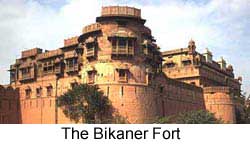
Bikaner is undoubtedly one of the most artistic, interesting, best preserved and well maintained forts in India, and its museum is deservedly well known. Each of the palaces contain particular treasures, like the famous 'hindola' or the swing, in the Anup Mahal, one of the few perfect specimens left. One courtyard is set with tiles to look like a carpet and it was here that fakirs used to dance upon swords, their sharp blades upturned.
The karni museum contains collections of Bikaner miniatures, shikar trophies and a very good armoury full of historical weapons and European guns. The Chandra Mahal, or Moon Palace, and the Phool Mahal, or the Palace of flowers, date from Raja Gaja Singh's time (mid-18th century), the later decorated with mortifs of flowers and delicately inlaid with mirrorwork.
Maharana Ganga Singh, who had come to the throne in 1887 at the age of seven, built Lalgarh, the Red Fort. It combined many renaissance techniques with Rajput traditions, but it was built outside the fortress walls.
The fort of Junagarh is a vivid example of Rajput fort architecture. At the very top of the fort, built on the roof of one palace, is a single room, its white ceiling shaped like the roof of a tent and painted in red and gold with flowers, leaves and a frieze of graceful dancing rajput ladies. From the ceiling, a heavy embroidered 'Punkha' or fan hangs and sways over a low bed on silver feet. This was the favourite room of the Maharaja, somehow embodying in its delicate beauty the whole of Bikaners extraordinary artistic flowering in the midst of desolation.




